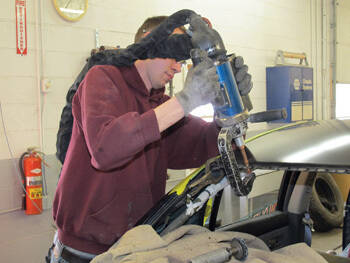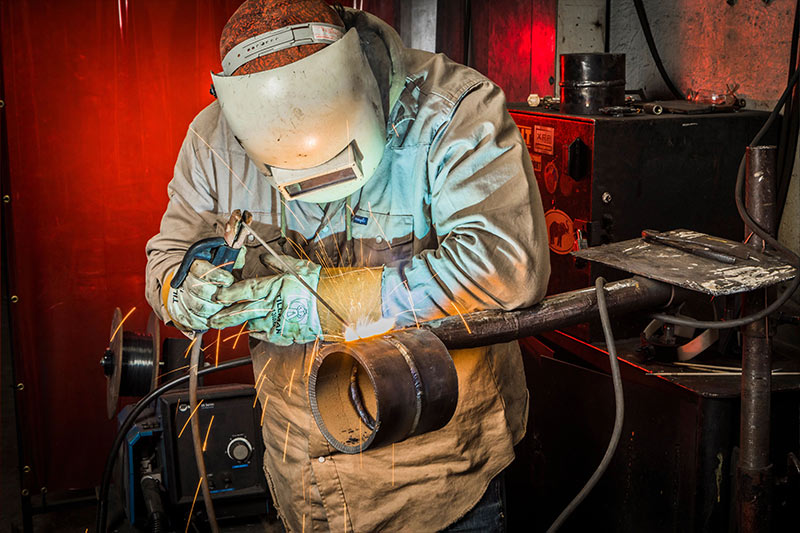Common Welding Fixing Issues and Exactly How to Address Them Successfully
Welding repairs often experience a range of concerns that can jeopardize the stability of the last product. Typical issues include insufficient penetration, porosity, and imbalance, to name a few. Each problem presents one-of-a-kind obstacles that require certain methods for resolution. Comprehending these problems is vital for welders aiming to improve their results and skills. This discussion will explore these typical welding repair work problems and reliable methods to resolve them.
Poor Infiltration
Poor infiltration happens when the weld metal falls short to fully fuse with the base material, leading to weak joints and potential structural failures. This issue commonly originates from inadequate heat input, incorrect electrode angle, or incorrect welding speed. Welders might run into poor infiltration as a result of a mistake of the essential criteria for a certain material density or type. Furthermore, contamination on the base product's surface area can hinder reliable bonding, worsening the problem. To attend to insufficient infiltration, welders must guarantee ideal settings on their devices and keep a tidy work surface area. Routine examination of welds is suggested to recognize any kind of shortages early, permitting timely modifications and the avoidance of jeopardized structural stability in bonded settings up.
Porosity
Porosity is an usual defect in bonded joints that shows up as little gas bubbles entraped within the weld metal. This problem can compromise the integrity of the weld, causing decreased toughness and potential failing under tension. Montana Mobile Welding and Repair Welding. Porosity generally develops from contamination, dampness, or incorrect welding techniques, which permit gases to leave into the molten weld pool. To address porosity, welders must assure appropriate surface area preparation, maintain a clean working setting, and utilize ideal welding specifications. In addition, picking the appropriate filler product and shielding gas can minimize gas entrapment. Regular examination and testing of welds can help recognize porosity early, ensuring prompt rehabilitative actions are taken, consequently preserving the quality and reliability of the bonded framework
Imbalance
Imbalance in welding can develop from different elements, including improper setup and thermal expansion. Recognizing the root causes is essential for effective resolution. A number of improvement methods are offered to straighten elements and ensure structural stability.
Reasons of Misalignment
Welding misalignment often originates from a range of underlying issues that can endanger architectural integrity. One main reason is incorrect fit-up of parts before welding, which can cause voids and unequal surfaces. Variations in thermal expansion throughout the welding process can also lead to distortion, particularly if the products being signed up with have various coefficients of development. Additionally, poor fixturing and securing may stop working to hold components safely in position, leading to motion throughout welding. Inadequately kept equipment, consisting of welding equipments and devices, may introduce incongruities in the weld bead, more contributing to imbalance. Operator error, stemming from not enough training or experience, can likewise play a considerable role in producing misaligned welds.

Modification Strategies Offered
Attending to imbalance effectively needs a combination of rehabilitative methods tailored to the certain concerns at hand. One common technique is using jigs or components to hold parts in the proper position during welding, making sure regular positioning. In addition, pre-heating the materials can assist decrease distortion and enhance fit-up. For considerable misalignment, mechanical realignment techniques, such as making use of hydraulic jacks or clamps, can be used to remedy the position before welding. Post-weld warm therapy might additionally be required to soothe stress and anxieties triggered by imbalance. Careful examination and modification during the arrangement stage can avoid imbalance issues from ending up being significant troubles, advertising a smoother welding process and boosting general structural stability.
Distortion
Distortion is a common challenge in welding that can emerge from different aspects, consisting of uneven heating and air conditioning. Comprehending the reasons for distortion is crucial for implementing efficient avoidance strategies. Resolving this issue not just improves architectural integrity yet also enhances the total quality of the weld.
Sources of Distortion
When subjected to the intense heat of welding, products usually undergo adjustments that can result in distortion. This phenomenon primarily arises from thermal expansion and contraction throughout the welding procedure. As the weld area heats up, the material broadens; upon air conditioning, it contracts, which can produce internal stress and anxieties. Additionally, irregular home heating across a work surface can worsen these stress and anxieties, causing warping or bending. The kind of material also plays a significant duty; steels with varying thermal conductivity and coefficients of growth might respond differently, leading to unforeseeable distortions. Bad joint layout and inadequate fixturing can contribute to imbalance during welding, increasing the probability of distortion. Recognizing these causes is crucial for reliable welding repair and prevention strategies.
Prevention Techniques
Reliable prevention strategies for distortion during welding concentrate on controlling warmth input and making sure proper joint style. Keeping a consistent heat input assists to minimize thermal growth and contraction, which can bring about distortion. Utilizing techniques such as pre-heating the workpiece can likewise minimize the temperature slope, advertising uniform heating. Furthermore, picking ideal joint designs, such as T-joints or lap joints, can boost security and lower stress and anxiety focus. Implementing correct fixturing to safeguard the workpieces in location additionally help in keeping placement during the welding process. Staggered welding sequences can distribute heat more evenly, protecting against localized distortion. By using these methods, welders can greatly lower the chance of distortion and improve the total top quality of their welds.
Breaking
Splitting is a common concern encountered in welding repair work, typically arising from different variables such as inappropriate air conditioning rates, material option, or insufficient joint preparation. The event of cracks can greatly compromise the stability of the weld, causing possible failings throughout operation. To resolve this issue, welders must first assess the origin, guaranteeing that products work and suitably picked for the specific application. Additionally, controlling the cooling rate during the welding procedure is essential; fast air conditioning can induce anxiety and bring about splitting. Appropriate joint layout and prep work likewise contribute to lessening the risk. Executing these methods can enhance weld high quality and durability, inevitably decreasing the possibility of breaking in completed more info weldments.

Incomplete Combination
A substantial problem in welding repair services is insufficient combination, which takes place when the weld metal does not properly bond with the base product or previous weld passes - Montana Mobile Welding and Repair Welding. This problem can bring about weak points in the joint, possibly compromising the integrity of the bonded framework. Variables adding to insufficient combination consist of insufficient warmth input, inappropriate welding technique, and contamination of the surface areas being joined. To address this issue successfully, welders should ensure correct pre-weld cleaning and surface area prep work, along with change their welding specifications to attain sufficient infiltration and blend. Routine examination throughout the welding procedure can likewise help determine insufficient fusion early, enabling prompt rehabilitative actions to improve the general high quality of the weld
Overheating
While welding fixings can improve architectural integrity, overheating provides a significant challenge that can bring about material deterioration. Excessive warmth throughout welding can change the mechanical properties of steels, leading to lowered strength, raised brittleness, and bending. This phenomenon is specifically essential in high-stress applications where architectural reliability is paramount. Determining overheating can include aesthetic assessments for staining or distortion, along with keeping track of temperature throughout the welding process. To reduce the risks linked with overheating, welders need to use proper methods, such as regulating heat input, changing traveling rate, and using ideal filler materials. In addition, carrying out pre- and post-weld warmth treatments can aid bring back material properties and boost the overall top quality of the repair, guaranteeing long-term efficiency and security.
Frequently Asked Concerns
What Are the Common Signs of a Welding Flaw?

How Can I Check My Welds for Top quality?
To evaluate welds for top quality, one can utilize visual examinations, ultrasonic testing, and radiographic approaches. Each technique assures architectural integrity, recognizes issues, and confirms adherence to specified criteria, eventually boosting the reliability of the bonded joints.
What Security Precautions Should I Take While Welding?
When welding, one should focus on safety by wearing proper individual safety devices, ensuring correct ventilation, securing flammable materials away, preserving a tidy office, and knowing environments to stop injuries and mishaps.
Can I Fix a Weld Without Remodeling the Entire Joint?
Fixing a weld without redesigning the whole joint is possible, depending upon the damages (Montana Mobile Welding and Repair). Techniques such as grinding, adding filler product, or making use of a welding procedure can efficiently attend to certain imperfections while preserving the surrounding structure
What Devices Are Essential for Efficient Welding Repair Works?
Essential tools for effective welding fixings include a welding machine, cord brush, mill, protective equipment, clamps, and filler products. Each tool plays a vital function in making certain high quality and safety and security during the repair service procedure. Porosity normally emerges from contamination, dampness, or improper welding methods, which enable gases to leave right into the molten weld swimming pool. Badly conserved tools, consisting of welding makers and devices, may introduce disparities in the weld bead, more contributing to imbalance. When subjected to the extreme warm of welding, materials usually undergo changes that can lead to distortion. Cracking is an usual problem experienced in welding fixings, typically resulting from different aspects such as improper air conditioning prices, product selection, or poor joint prep work. A substantial concern in welding repairs is incomplete blend, which takes place when the weld metal does not appropriately bond with the base product or previous weld passes.